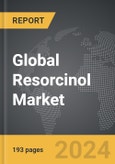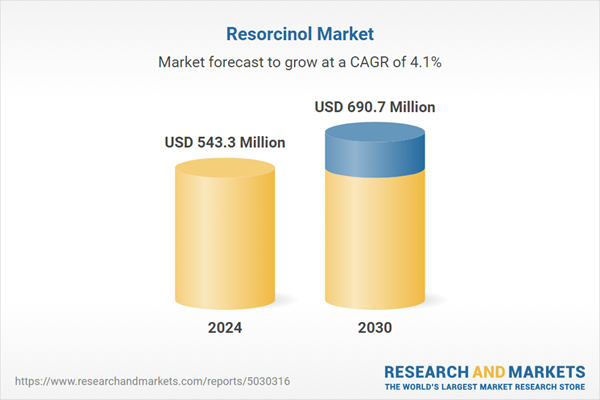Global Resorcinol Market - Key Trends & Drivers Summarized
How Is Resorcinol Transforming Performance and Durability in Rubber-Based Applications?
The use of resorcinol in rubber products is a defining segment of the global market, driven by its ability to enhance the mechanical bonding between rubber and reinforcing materials like nylon, polyester, or steel cord. It plays a central role in the formulation of resorcinol-formaldehyde-latex (RFL) adhesives, which are widely used in manufacturing tires, conveyor belts, and other industrial rubber goods. As global demand for durable and high-performance automotive tires increases - particularly in commercial transportation and electric vehicle sectors - the reliance on resorcinol-based adhesives becomes ever more critical. The superior bonding strength provided by RFL systems contributes directly to tire longevity, heat resistance, and structural integrity under dynamic stress, meeting the performance demands of modern vehicular engineering.Beyond automotive, resorcinol sees significant application in industrial belts, rubber hoses, and vibration dampening components, where high adhesion and thermal resistance are crucial. In recent years, the surge in electric vehicle (EV) adoption has introduced new design paradigms requiring lighter, safer, and more durable tires. These emerging dynamics are enhancing resorcinol consumption, especially in premium tire segments that demand advanced composite bonding. Meanwhile, environmental regulations and health safety guidelines are pushing manufacturers toward modified resorcinol derivatives or bio-based alternatives that retain similar efficacy while reducing formaldehyde emissions. Such innovation is ensuring that resorcinol remains a key contributor to sustainable manufacturing practices in the high-performance rubber industry.
Why Is Resorcinol Gaining Ground in Adhesive Technologies for Wood and Laminates?
In wood adhesives, resorcinol has long been valued for its moisture resistance, thermal stability, and structural bond strength, especially in harsh environmental conditions. Phenol-resorcinol-formaldehyde (PRF) adhesives, commonly employed in load-bearing wood structures, laminated beams, exterior plywood, and marine-grade applications, offer outstanding resistance to delamination caused by weather exposure. These properties make resorcinol-based adhesives particularly important in the construction of bridges, log homes, and commercial buildings where long-term structural integrity is paramount. As timber regains popularity in modern construction due to its low carbon footprint, the demand for resorcinol-based adhesives is poised for strong growth across global markets.Technological advancements are also enabling the broader application of resorcinol adhesives in cross-laminated timber (CLT) and engineered wood products (EWP), both of which are experiencing accelerated adoption in urban infrastructure development. The compound's superior adhesion profile under high stress and moisture makes it uniquely suited for sustainable architectural designs, including high-rise wooden buildings. Concurrently, regulatory developments in Europe and North America emphasizing formaldehyde emission standards are triggering a shift toward modified or low-emission PRF adhesives. Research into hybrid resins, blending resorcinol with newer chemistries for enhanced environmental performance, is shaping future market directions while retaining core structural benefits critical for demanding construction applications.
Can Resorcinol Sustain Its Relevance Amid Emerging Trends in UV and Flame Protection?
Resorcinol's multifunctionality is increasingly evident in specialized applications such as UV stabilization and flame retardancy. In UV stabilizers, resorcinol derivatives - especially bisphenol compounds - are integral to formulating light-stabilizing systems for plastics, coatings, and films. These compounds extend the lifespan of consumer products by preventing discoloration, degradation, and brittleness under prolonged sun exposure. Industries such as outdoor furniture, automotive interior components, and agricultural films benefit from such stabilization, which is vital for performance and appearance retention. Rising demand for high-durability polymeric materials across these sectors is contributing to a steady expansion in the UV stabilizer segment where resorcinol plays a pivotal role.Simultaneously, resorcinol-based flame retardants are emerging as critical components in electronics and building materials, especially where halogen-free formulations are required to meet fire safety standards. Its inclusion in epoxy resins, circuit boards, and polyurethane foams contributes to delaying ignition and suppressing smoke generation. The growing emphasis on eco-friendly and low-toxicity flame retardants, particularly across Europe and Asia-Pacific, aligns with the development of resorcinol phosphate and related compounds. These developments are enabling electronics manufacturers to comply with stringent flammability regulations without compromising performance. Additionally, niche uses of resorcinol in photographic developers, dyes, and pharmaceutical intermediates continue to provide diversified growth pathways, albeit on a smaller scale compared to its core industrial applications.
The Growth in the Resorcinol Market Is Driven by Several Factors That Reshape Its Demand Across Industrial Verticals
The expansion of the global resorcinol market is propelled by multiple converging factors across diverse application domains. In the automotive industry, heightened requirements for tire safety, structural strength, and longevity - especially under the weight demands and torque characteristics of electric and hybrid vehicles - are increasing reliance on RFL adhesives, where resorcinol is a primary component. Simultaneously, a robust construction sector fueled by green building initiatives and sustainable urbanization is boosting demand for PRF adhesives in engineered wood structures, thus reinforcing resorcinol's role as a critical bonding agent in architectural innovation.In the electronics sector, the miniaturization of devices and stricter flammability regulations are creating new avenues for resorcinol-based flame retardants, particularly in the design of heat-resistant printed circuit boards and housing materials. End-use industries such as building & construction and medical devices are also witnessing increased utilization of UV-stabilized polymers, with resorcinol compounds enhancing durability under sunlight and sterilization conditions. Consumer behavior is shifting toward eco-conscious materials, prompting the development of bio-based and formaldehyde-free resorcinol formulations that meet evolving health and environmental standards. Additionally, regional policy shifts favoring domestic manufacturing in Asia-Pacific, especially China and India, are supporting backward integration of resorcinol in vertically aligned supply chains. These cumulative drivers underscore resorcinol's continued evolution from a legacy chemical into a high-impact functional compound across emerging and traditional sectors alike.
Report Scope
The report analyzes the Resorcinol market, presented in terms of market value (USD). The analysis covers the key segments and geographic regions outlined below.- Segments: Application (Rubber Products Application, Wood Adhesives Application, UV Stabilization Application, Flame Retardants Application, Other Applications); End-Use (Medical End-Use, Automotive End-Use, Building & Construction End-Use, Electronics End-Use, Other End-Uses).
- Geographic Regions/Countries: World; United States; Canada; Japan; China; Europe (France; Germany; Italy; United Kingdom; Spain; Russia; and Rest of Europe); Asia-Pacific (Australia; India; South Korea; and Rest of Asia-Pacific); Latin America (Argentina; Brazil; Mexico; and Rest of Latin America); Middle East (Iran; Israel; Saudi Arabia; United Arab Emirates; and Rest of Middle East); and Africa.
Key Insights:
- Market Growth: Understand the significant growth trajectory of the Rubber Products Application segment, which is expected to reach US$239.5 Million by 2030 with a CAGR of 3.8%. The Wood Adhesives Application segment is also set to grow at 4.4% CAGR over the analysis period.
- Regional Analysis: Gain insights into the U.S. market, valued at $86.3 Million in 2024, and China, forecasted to grow at an impressive 5.1% CAGR to reach $203.1 Million by 2030. Discover growth trends in other key regions, including Japan, Canada, Germany, and the Asia-Pacific.
Why You Should Buy This Report:
- Detailed Market Analysis: Access a thorough analysis of the Global Resorcinol Market, covering all major geographic regions and market segments.
- Competitive Insights: Get an overview of the competitive landscape, including the market presence of major players across different geographies.
- Future Trends and Drivers: Understand the key trends and drivers shaping the future of the Global Resorcinol Market.
- Actionable Insights: Benefit from actionable insights that can help you identify new revenue opportunities and make strategic business decisions.
Key Questions Answered:
- How is the Global Resorcinol Market expected to evolve by 2030?
- What are the main drivers and restraints affecting the market?
- Which market segments will grow the most over the forecast period?
- How will market shares for different regions and segments change by 2030?
- Who are the leading players in the market, and what are their prospects?
Report Features:
- Comprehensive Market Data: Independent analysis of annual sales and market forecasts in US$ Million from 2024 to 2030.
- In-Depth Regional Analysis: Detailed insights into key markets, including the U.S., China, Japan, Canada, Europe, Asia-Pacific, Latin America, Middle East, and Africa.
- Company Profiles: Coverage of players such as Akrochem Corporation, Alfa Aesar, Amino-Chem Co., Ltd., Atul Ltd., Emco Dyestuff Pvt. Ltd. and more.
- Complimentary Updates: Receive free report updates for one year to keep you informed of the latest market developments.
Some of the 59 companies featured in this Resorcinol market report include:
- Akrochem Corporation
- Alfa Aesar
- Amino-Chem Co., Ltd.
- Atul Ltd.
- Emco Dyestuff Pvt. Ltd.
- GFS Chemicals, Inc.
- Haihang Industry Co. Ltd.
- Jay Organics
- Kraeber & Co GmbH
- Mitsui Chemicals, Inc.
- Nippy Chemicals
- Parchem Fine & Specialty Chemicals, Inc.
- Sanjay Chemicals (India) Pvt. Ltd.
- Sinoright International Trade Co., Ltd
- Sumitomo Chemical Co., Ltd.
This edition integrates the latest global trade and economic shifts into comprehensive market analysis. Key updates include:
- Tariff and Trade Impact: Insights into global tariff negotiations across 180+ countries, with analysis of supply chain turbulence, sourcing disruptions, and geographic realignment. Special focus on 2025 as a pivotal year for trade tensions, including updated perspectives on the Trump-era tariffs.
- Adjusted Forecasts and Analytics: Revised global and regional market forecasts through 2030, incorporating tariff effects, economic uncertainty, and structural changes in globalization. Includes historical analysis from 2015 to 2023.
- Strategic Market Dynamics: Evaluation of revised market prospects, regional outlooks, and key economic indicators such as population and urbanization trends.
- Innovation & Technology Trends: Latest developments in product and process innovation, emerging technologies, and key industry drivers shaping the competitive landscape.
- Competitive Intelligence: Updated global market share estimates for 2025, competitive positioning of major players (Strong/Active/Niche/Trivial), and refined focus on leading global brands and core players.
- Expert Insight & Commentary: Strategic analysis from economists, trade experts, and domain specialists to contextualize market shifts and identify emerging opportunities.
Table of Contents
Companies Mentioned (Partial List)
A selection of companies mentioned in this report includes, but is not limited to:
- Akrochem Corporation
- Alfa Aesar
- Amino-Chem Co., Ltd.
- Atul Ltd.
- Emco Dyestuff Pvt. Ltd.
- GFS Chemicals, Inc.
- Haihang Industry Co. Ltd.
- Jay Organics
- Kraeber & Co GmbH
- Mitsui Chemicals, Inc.
- Nippy Chemicals
- Parchem Fine & Specialty Chemicals, Inc.
- Sanjay Chemicals (India) Pvt. Ltd.
- Sinoright International Trade Co., Ltd
- Sumitomo Chemical Co., Ltd.
Table Information
| Report Attribute | Details |
|---|---|
| No. of Pages | 535 |
| Published | January 2026 |
| Forecast Period | 2024 - 2030 |
| Estimated Market Value ( USD | $ 543.3 Million |
| Forecasted Market Value ( USD | $ 690.7 Million |
| Compound Annual Growth Rate | 4.1% |
| Regions Covered | Global |









